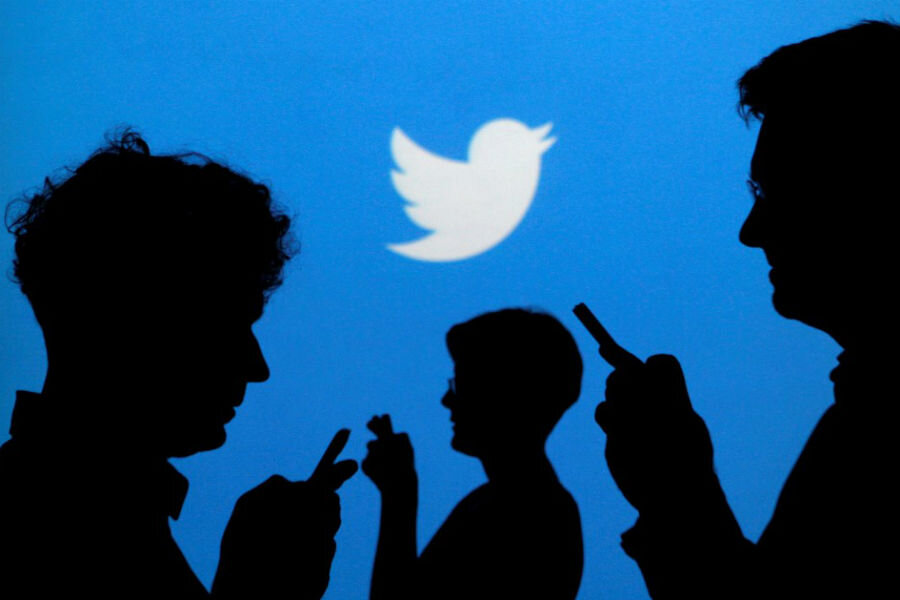What's behind the rise in anti-Semitism toward journalists on Twitter?
Loading...
Twitter, with its hashtags, memes, and 140-character limits, has long served as a bridge between high-profile figures and ordinary citizens.
But some of these interactions have taken a noticeably darker turn this election season, as demonstrated by a recent report by the Anti-Defamation League (ADL). Between August of 2015 and this past July, Twitter experienced a sharp uptick in the number of anti-Semitic tweets directed toward journalists, with at least 800 journalists on the receiving end of such messages. Many of the tweets, the report found, originated from Twitter users identifying as Trump supporters, "conservatives," or "nationalists."
The sentiments expressed in these tweets – and the presence of trolls on Twitter, a social network that allows for easy anonymity and provides a global reach – are not new phenomena. But the ADL report highlights the emergence of the so-called alt-right, a largely-online movement rooted in white, Christian nationalism that has gained national notoriety in recent months due to its growing presence on social media and the rhetoric of Republican nominee Donald Trump.
"These ideas and these strains ... have been around since the beginning of the republic. But they were atomized in the past because we didn't have the communications vehicles that we have now," said Norman Ornstein, co-author of "It's Even Worse Than It Looks: How the American Constitutional System Collided With the New Politics of Extremism," in an interview with NPR’s Diane Rehm.
"Now," he continued, "with social media, you can organize and create a community that reinforces itself and I think ... Donald Trump gives this a legitimacy now that allows them both to speak out and to organize in ways that we hadn't seen before."
While blatantly racist or anti-Semitic statements are considered at worst appalling and at best taboo outside of right-wing extremist circles, sending an insulting or offensive tweet is considered brave, not shameful, among members of the alt-right and similar movements, says Nicole Hemmer, an assistant professor of presidential studies at the University of Virginia's Miller Center.
"There’s this belief that society has sort of circumscribed our language and there are certain things that you cannot say because it’s a violation against taboos," she tells The Christian Science Monitor in a phone interview. To push back against that "PC culture" by demonstrating "free speech fundamentalism," Dr. Hemmer says, "becomes an act of freedom rather than an act of offensiveness."
The alt-right movement can be traced back to the 1950s, when the GOP establishment began to reject extreme elements such as racists and anti-Semites, according to historians. But the largely-online movement has gained significant momentum and national recognition in the past year due to the candidacy of Donald Trump. As Patrik Jonsson reported for the Monitor in August:
As the New York mogul has driven some of his base away – including, significantly, suburban white women – he has had to reach deeper and deeper into the conservative movement for fans. He has landed on a strain of American politics that may be as vexing as it is apparently ascendant.
...
But whether it ultimately plays into Trump’s gambit, the alt-right’s emergence on the political scene is indisputably having an influence, one which will be hard to ignore as the country gets ready to retire its first black president.
Social networking sites such as Twitter, which allows for easy anonymity and communication with like-minded people all over the world, provide an ideal medium for right-wing extremists wishing to spread their message with minimal risk, experts say.
Social media, especially around election time, has a tendency to become an "ugly soapbox" for people of all political leanings, Brian Solis, principal analyst at the research firm Altimeter Group, told CIO: "It brings out the darker side of digital introverts in that we are willing to say anything ... without logically thinking about its impact on what's reality and what people will think about us beyond this election."
Twitter in particular, which does not require users to use a real name or photo and allows any user to tag any other user in a tweet, has allowed those wishing to spread racist, sexist, or anti-Semitic messages to more easily attract the attention of high-profile figures.
"Social media affords users the unique ability to send hateful speech that both targets a specific individual, intimidating them, and reaches a broad audience of like-minded individuals – the user’s followers," says Drew Margolin, assistant professor of communication at Cornell University, in an email to the Monitor. "It's like being able to shout obscenities at a ballplayer at the stadium where only he and your friends hear you."
The targeting of journalists, as highlighted in the ADL's report, may be due in part to resentment toward the mainstream media, fueled in part by the anti-media sentiments of Donald Trump.
But the pattern may also reflect a strategy among members of the alt-right to attract the attention of those who have the capability to raise awareness of the movement, Hemmer says.
"Yes, they’re targeting journalists because they think journalists don't represent them, but it’s also strategic," she explains. "If you tweet at a journalist, particularly shocking things, it gets their attention."
And, as evidenced by an increase in mainstream media coverage of such fringe groups this election season, it may be working: "I do think it's how journalists became more aware of the alt-right and the philosophy of the alt-right," Hemmer adds.








